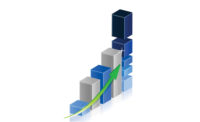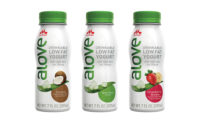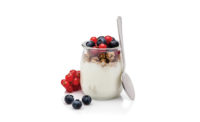Our annual report card grades the various categories of dairy foods and beverages. None fail, but clearly, product developers need to bone up on chemistry to develop exciting new products. Remedial work in marketing principles will help convey dairy’s nutritional benefits.
Milk
Processors develop specialized products for niche markets.
Cheese
Cheesemakers go for the bold (flavors), while foodies flock to artisanal products.
Cultured
Greek yogurt is the story of the year, and there are innovations in cream cheese.
Ice Cream
It’s a fun food, but processors are having a tough time as sales slide.
Butter
No one puts butter in a corner. Consumers and chefs appreciate its flavor.
Beverages
Trends in nondairy beverages include customization of waters and flavor combinations in juices.
Ingredients
Inclusions and colors encourage ‘interactivity’ with dairy foods.
Exports
U.S. dairy processors will play a key role in fulfilling world market needs.
To order reprints of this special report, contact Jill DeVries, 248-244-1726 or devriesj@bnpmedia.com.
Dairy products are elementary
Milk, cheese, yogurt and butter are among the 10 items found in every shopper’s basket. Still, unit sales are flat (with some exceptions), although dollar sales are up, thanks to price inflation.
By Ellen Schmitz, SymphonyIRI Group
Dairy products are continuing to hit just the right note with today’s health-conscious consumers. From a morning glass of milk to a yogurt snack, consumers are turning to dairy as a meal component or even a meal replacement.
So, is this desire for health translating to solid sales growth for dairy products? According to SymphonyIRI analysis of the dairy department, the top 10 categories make up 81% of dollar sales and 83% of dollar gains in the latest 52 weeks. Milk, natural cheese and yogurt lead the pack and make up nearly half, or 47%, of absolute dollar sales and 56% of sale gains. Rounding out the top 10 categories in dollar sales are refrigerated juice/drinks, fresh eggs, salad/coleslaw, processed cheese, creams/creamer, butter and refrigerated side dishes.
Kefir makes gains in the milk category
Milk is the leader in dairy with annual sales of $11.6 billion. With nearly universal appeal, 91.2% of households purchase milk in a year and buy it 23.4 times a year. Still, the category has struggled during recent years, evidenced by volume declines of 3.9% during the past year. While, dollar sales are up by 1.9%, the growth is attributed to price increases.
Despite the fact that a whopping 87% of the category is made up of traditional white segments, the category hero is the kefir/milk substitutes/soymilk segment, which accounts for more than 40% of category dollar growth even though it only represents 6% of category dollar sales. The strength of these products is driven by the fact that three-quarters of consumers are looking to eat healthier, and new technology and ingredients have made plant-based milks richer and creamier without sacrificing taste and texture to be healthier.
Cheese is hot
Natural cheese holds the second position in the dairy category, with $8.2 billion in annual sales and 6.5% of dollar sales growth. This growth is due almost entirely to price, as consumption is flat at 0.5%. Like milk, cheese is in distribution everywhere and has an ACV of 99.9%. (ACV, or all commodity volume, is a measure of annual total store sales volume.) Natural shredded and natural chunk cheeses are the most popular varieties, representing 66% of category dollars and 68% of category growth. Private-label cheese is also a big winner with consumers and dominates the category with a 44% dollar share.
With 86.8% of households purchasing in a year and buying 12.8 times per year, it seems nearly everyone eats cheese. However, both penetration and occasions are flat. Again, shredded and chunk segments have the greatest appeal with 69.7% and 61.9% penetration, respectively.
Yogurt is cool
Yogurt is the third largest category in refrigerated dairy with annual sales of $4.8 billion and has broad-scale distribution with an ACV of 99.3%. Yogurt’s dollar growth of 8.6% is the highest rate among the top 10 categories. Yogurt makes the perfect snack for young and old alike, so it’s no surprise that nearly three-quarters of all households, or 71.3%, purchase yogurt. However, there are still opportunities in this diverse category, since penetration is down slightly (-1.2 points) versus the prior year.
Frozen is a treat
It’s hard to walk through the freezer section and not buy ice cream. In fact, ice cream and sherbet are the second-most popular items in the frozen department, with 14% of department dollar sales. Following closely behind in the No. 4 position is frozen novelties, such as ice cream sandwiches, with 9% of sales. Filling out the top five categories in the frozen department are dinners/entrées, pizza and seafood.
Ice cream/sherbet, at $4.6 billion in sales, accounts for 13.5% of frozen department sales. On top of this, it captured an astounding 53% of department dollar sales gains, which is an increase of $202 million versus the prior year. However, volume is down by 2%, indicating dollar growth is driven by a mix shift to more premium-priced products.
Within the category, ice cream is the dominant segment with 91% of sales, while the remainder of category sales is shared by frozen yogurt/tofu (5%) and sherbet/sorbet/ices segments (4%). Like the other dairy segments, private label does well and has the highest share with 26% of dollar sales.
The frozen novelties category is up very slightly with a 1.3% increase in dollar sales for a total of $2.9 billion in sales. Like ice cream, volume is down by 3.1%, even though these frozen treats can be found nearly everywhere with an ACV of 99.7%.
After a top-line review of the most popular dairy segments, let’s revisit the initial question: Is consumers’ desire for health translating to solid sales for dairy products? Overall, sales are up across the board. And, volume is either relatively flat or slightly down, but price per volume has increased across all categories. According to Food Institute analysis of USDA data, dairy products inflation came in at 6.25% to 6.75%, versus the food at home average of 2% to 2.5%, so inflation in dairy is much higher than the industry average. The price per volume increases were influenced both by inflation and decreased merchandising activity.
While consumers will still be grabbing milk on the go and their favorite yogurt for a nutritious snack, there are some exciting opportunities in this very diverse category, where there is literally something for everyone.



